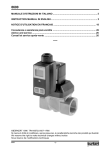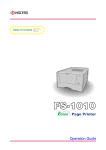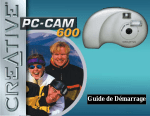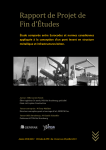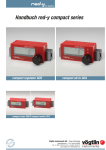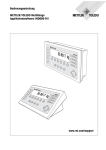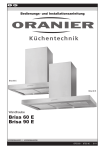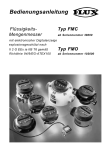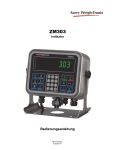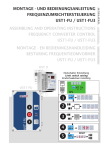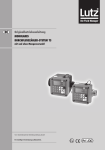Download BEDIENUNGSANLEITUNG IN DEUTSCH
Transcript
8600 BEDIENUNGSANLEITUNG IN DEUTSCH ................................................................... 2 INSTRUCTION MANUAL IN ENGLISH ....................................................................... 10 NOTICE D'UTILISATION EN FRANCAIS ................................................................... 18 Beratung und Service ................................................................................................ 26 Advice and service ..................................................................................................... 26 Conseil et service après-vente ................................................................................. 26 ***** ©BÜRKERT 1996 TR419573U-607-1-RM Technische Änderungen vorbehalten We reserve the right to make technical changes without notice Sous réserve de modifications techniques 8600 -1- INHALTSVERZEICHNIS 1 1.1 1.2 1.3 1.4 EINFÜHRUNG ....................................................................................................... 3 Auspacken und Kontrolle ...................................................................................... 3 Allgemeine Hinweise ............................................................................................. 3 Sicherheitshinweise ............................................................................................... 3 Elektromagnetische Verträglichkeit ....................................................................... 3 2 2.1 2.2 2.3 2.4 BESCHREIBUNG.................................................................................................. 4 Typenbezeichnung ................................................................................................ 4 Aufbau und Messprinzip ........................................................................................ 4 Abmessungen ........................................................................................................ 4 Technische Daten .................................................................................................. 5 3 3.1 3.2 3.3 3.4 INSTALLATION .................................................................................................... 6 Allgemeine Hinweise zum Einbau ......................................................................... 6 Einbau .................................................................................................................... 6 Allgemeine Hinweise zum elektrischen Anschluss ............................................... 7 Elektrischer Anschluss .......................................................................................... 7 4 4.1 4.2 BEDIENUNG ......................................................................................................... 8 Anzeige- und Bedienelemente .............................................................................. 8 Standardmodus ..................................................................................................... 9 4.2.1 Starten des Abfüllvorgangs .......................................................................... 9 4.2.2 Stoppen des Abfüllvorgangs ........................................................................ 9 4.2.3 Einlegen einer Pause ................................................................................... 9 Nachlaufkorrektur .................................................................................................. 9 Programmiermodus ............................................................................................... 9 4.4.1 Der Multiplikator des K-Faktors.................................................................. 10 4.4.2 Der K-Faktor ............................................................................................... 10 4.4.3 Der Multiplikator der Abfüllmenge .............................................................. 10 4.4.4 Die Abfüllmenge ......................................................................................... 10 Teach-In-Modus .................................................................................................. 10 4.5.1 Abfüllen per Teach-In ................................................................................. 11 4.5.2 Keine Eingabe der Abfüllmenge ................................................................ 11 4.5.3 Ermittlung eines K-Faktors / Eingabe der Abfüllmenge............................. 11 Hinweise zum Betrieb .......................................................................................... 11 Auslieferungszustand des Dosiergerätes ........................................................... 11 Fehlermeldungen ................................................................................................. 12 4.3 4.4 4.5 4.6 4.7 4.8 ANHANG: Anschlussmöglichkeiten ......................................................................... 16 8600 -2- 1 EINFÜHRUNG Sehr geehrter Kunde, 1.3 Sicherheitshinweise wir beglückwünschen Sie zum Kauf unseres kompakten Dosiergerätes 8600. Sie haben eine gute Wahl getroffen. Um die vielfältigen Vorteile, die Ihnen das Produkt bietet, voll nutzen zu können, befolgen Sie bitte unbedingt unseren Rat und Bürkert stellt verschiedene Dosiergeräte her. Jedes kann in einer Vielfalt von Applikationen eingesetzt werden. Gerne beraten wir Sie hierzu. Es liegt jedoch in der Verantwortung des Kunden, das zu seiner Applikation optimal passende Gerät zu wählen, es korrekt zu installieren und instandzuhalten. LESEN SIE DIESE BEDIENUNGSANLEITUNG GRÜNDLICH, BEVOR SIE DAS GERÄT MONTIEREN UND IN BETRIEB NEHMEN. Dieses Symbol erscheint in der Bedienungsanleitung jedesmal wenn besondere Vorsicht geboten ist, um eine einwandfreie Installation, Funktion und Betriebssicherheit des Gerätes zu gewährleisten. ! 1.1 Auspacken und Kontrolle Bitte überprüfen Sie die Lieferung auf Vollständigkeit und Transportschäden. Zur Standardlieferung gehören: 1.4 Elektromagnetische Verträglichkeit -1Stück Dosiergerät Typ 8600 -1Stück Bedienungsanleitung Hiermit wird bestätigt, dass dieses Produkt den wesentlichen Schutzanforderungen entspricht, die in der Richtlinie des Rates zur Angleichung der Rechtsvorschrifften der Mitgliedstaaten über elektromagnetische Verträglichkeit (89/336/EWG) festgelegt sind. Bei Verlust oder Schäden wenden Sie sich an Ihre Bürkert Niederlassung. 1.2 Allgemeine Hinweise Diese Druckschrift enthält keine Garantiezusagen. Wir verweisen hierzu auf unsere allgemeinen Verkaufs- und Lieferbedingungen. Einbau und/oder Reparatur dürfen nur durch eingewiesenes Personal erfolgen. Sollten bei der Installation oder der Inbetriebnahme Schwierigkeiten auftreten, setzen Sie sich bitte sofort mit unserer nächsten Niederlassung in Verbindung. 8600 -3- 2 BESCHREIBUNG 2.1 Typenbezeichnung Bezeichnung 8600 Kompaktes Dosiergerät 1077-4 Bedieneinheit für 8600 Kabeldurchführung PG9 Ident Nr. 130429W 130447Y 2.2 Aufbau und Messprinzip Aufbau Messprinzip Das Dosiergerät Typ 8600 besteht aus einer Elektronik in einem spritzwassergeschützten Kunststoffgehäuse, Schutzart IP65. Das Gerät wird direkt auf ein Bürkert Magnetventil gesteckt und an einen Durchfluss-Sensor 8020 angeschlossen. Die verschiedenen Anschlüsse erfolgen auf einer 7-poligen Anschlussklemme über eine PG 9-Kabeldurchführung. Das Dosiergerät ist eine Schnittstelle die das Frequenzsignal des 8020 verwendet um ein Abfüllvorgang direkt über ein Magnetventil zu steuern. Die Abfüllmenge und der K-Faktor (abhängig von Rohrdurchmesser und Material) werden mittels der Bedieneinheit 1077-4 eingegeben. Die Steuerung eines Abfüllvorgangs kann entweder über die Bedieneinheit oder über die Binäreingänge erfolgen. Das Dosiergerät benötigt zum Betrieb eine Spannungsversorgung von 24...48 V AC/DC. 2.3 Abmessungen Ohne Bedieneinheit 1077-4 8600 Mit Bedieneinheit 1077-4 -4- 3 INSTALLATION 2.4 Technische Daten Umgebungstemperatur Lagertemperatur Relative Luftfeuchtigkeit Schutzart -10 bis 60°C (14 bis 140°F) -10 bis 80°C (14 bis 176°F) 80 % IP 65 Signaleingang Signalart Genauigkeit Eingangswiderstand Binäreingänge: Schaltzeit Frequenzeingang 1...500 Hz Sinus/Rechteck/Dreieck (>300 mVss) +/- 1 Impuls >10 kΩ ca. 0,5 - 1 Sek. Anschluss 7-polige Klemmleiste + PE Drahtquerschnitt max. 0,5 mm2 Spannungsversorgung 24...48 V AC/DC ! Achtung!: Die Anschluss-Spannung und die Stromart muss immer gleich den Anschlusswerten des Magnetventils sein. Gehäuse Werkstoff PA Gewicht ca. 50 g 8600 -5- 3 INSTALLATION 3.1 Hinweise zum Einbau Abb.1 Einbau Dosiergerät Das Gerät ist vor Dauerwärmestrahlung und anderen störenden Umwelteinflüssen zu schützen (z.B. Magnetfelder oder Dauersonnenbestrahlung). 3.2 Einbau (Abb. 1) Das Dosiergerät Typ 8600 wird direkt auf das Magnetventil gesteckt (siehe Abb.1) und durch die Zylinderschraube M 3x45 mm, festgeschraubt. Drehen der Anschlussplatte (Abb. 2) Achtung: Nur im spannungsfreien Zustand! Mit der Schraubendreherklinge unterfassen und die Anschlussplatte vorsichtig aushebeln. Die Anschlussplatte ist um 2 x 90°, von der Standardposition ab, in jede Richtung drehbar. Abb. 2 Drehen der Anschlussplatte Hinweis: Die Kabelenden dabei nicht abdrehen! Die Anschlussplatte ins Gehäuse einsetzen bis sie einrastet. 2 x 90° 8600 -6- 2 x 90° 3 INSTALLATION 3.3 Allgemeine Hinweise zum elektrischen Anschluss Die Anschlussleitung führt die Spannungsversorgung und das Mess-Signal und darf nicht zusammen mit Starkstromleitungen oder Hochfrequenz führenden Leitungen verlegt werden. Ist eine Zusammenverlegung unvermeidlich, so ist ein Mindestabstand von 30 cm (1 ft) einzuhalten oder abgeschirmte Leitung zu verwenden. Bei abgeschirmten Leitungen ist darauf zu achten, dass die Abschirmung einwandfrei geerdet ist. Bei normalen Betriebsbedingungen genügt einfaches Kabel mit Querschnitt 0,5 mm2 zur Übertragung des MessSignales. Im Zweifelsfall jedoch stets abgeschirmtes Kabel verwenden. Die Spannungsversorgung muss von guter Qualität sein (gefiltert und stabilisiert). ! Achtung!: Um die EMV-Richtlinien einzuhalten ist der Schutzleiter anzuschliessen. 3.4 Elektrischer Anschluss Abb. 3 Elektrischer Anschluss Zentralschraube lösen und Deckel abnehmen. Das Kabel durch die PG 9Verschraubung führen und gemäss folgender Anschlussbelegung beschalten (Abb. 3): 1: Binäreingang Start/Stop 2: GND 3: Binäreingang Reset 4: Frequenzeingang 5: Frequenzeingang 6: L+(24...48V AC/DC) 7: GND 8: Erde Anschlussmöglichkeiten: siehe Anhang 8600 -7- 4 BEDIENUNG Betrieb ohne Bedieneinheit Typ 1077-4 Beim Betrieb ohne Bedieneinheit Typ 1077-4 kann das Gerät über die beiden Binäreingänge START/STOP und RESET bedient werden. Es können allerdings keine Werte umprogrammiert werden, so dass immer nur die gleiche Menge abgefüllt werden kann. Um Werte zu verändern wird die Bedieneinheit Typ 1077-4 benötigt. Betrieb mit Bedieneinheit Typ 1077-4 Die Bedieneinheit wird anstelle des Gerätedeckels auf das Dosiergerät Typ 8600 gesteckt. Sie kann um je 180° gedreht werden. Bei Aufstecken der Bedieneinheit muss die Spannungsversorgung abgeschaltet sein, da sonst eine Umprogrammierung und somit ein Funktionsverlust des Dosiergeräts erfolgen kann. ! Beim Betrieb mit der Bedieneinheit sind drei Zustände möglich: Standardmodus Programmiermodus Teach-In-Modus Das Dosiergerät speichert beim Ausschalten die zuletzt eingestellten Daten. Bei Aufstecken der Bedieneinheit werden alle benötigten Daten an diese übertragen und gespeichert. Nach Beenden des Programmier- oder Teach-In-Modus werden alle eingestellten Daten von der Bedieneinheit an den Batch Controller übertragen. Danach kann der 8600 ohne Bedieneinheit 1077-4 betrieben werden. 4.1 Anzeige- und Bedienelemente Ventilzustand geöffnet/ geschlossen 4 1/2-Stellige Anzeige für Abfüllmenge. Die Anzeige -.- deutet darauf hin, dass nach einer Eingabe im Teach-In-Verfahren keine Abfüllmenge eingegeben wurde. Nicht benutzt x1 x10 188.:88 zeigt den Programmier- und Teach-In-Modus an Bargraph: Darstellung der bisher abgefüllten Menge in Teilen der Abfüllmenge Reset-Taste Werte bestätigen Start-Taste Werte verändern 8600 -8- 4 BEDIENUNG 4.2 Standardmodus Nach dem Einschalten der Betriebsspannung leuchten zunächst für ca. 2 Sek. alle Segmente der Bedieneinheit auf (Anzeigetest). Anschliessend wird die aktuelle Abfüllmenge angezeigt. Mit den beiden Tasten der Bedieneinheit oder mit den Binäreingängen kann das Gerät jetzt gestartet, gestoppt oder eine Pause eingelegt werden. 4.2.1 Starten des Abfüllvorgangs a) Durch kurzes Betätigen der Start-Taste b) Durch kurzes Betätigen des Binäreingangs für START (über Taster) 4.2.2 Stoppen des Abfüllvorgangs a) Durch kurzes Betätigen der Reset-Taste b) Durch kurzes Betätigen des Binäreingangs für RESET (über Taster) Das Ventil wird hierbei geschlossen und der Abfüllvorgang abgebrochen, d. h. es erscheint jetzt wieder die volle Abfüllmenge auf dem Display und der Abfüllvorgang kann von Neuem beginnen. ! Binäreingänge nur über Taster schalten, keine Schalter verwenden. 4.2.3 Einlegen einer Pause Wird während eines Abfüllvorgangs die Start-Taste bzw. der entsprechende Binäreingang gedrückt, so wird das Ventil geschlossen und der Abfüllvorgang angehalten. Wird die Taste erneut gedrückt, so wird das Ventil wieder geöffnet und der Abfüllvorgang fortgesetzt. 4.3 Nachlaufkorrektur Ist der Abfüllvorgang beendet, wird das Schaufelrad des Sensors 8020 auf eventuelles Nachlaufen nach dem Schliessen des Ventils überprüft. Bei jedem weiteren Vorgang wird dann dieser ermittelte Wert automatisch von der Abfüllmenge abgezogen. 4.4 Programmiermodus (siehe Abb.6 ) Wird die Reset-Taste ca. 2 Sek. lang gedrückt, so schaltet sich das Gerät in den Programmiermodus. Nacheinander können jetzt K-Faktor und Abfüllmenge eingestellt werden. Jede Stelle wird für sich einzeln in der Reihenfolge der nachfolgenden Kapitel eingestellt. Der aktuell einstellbare Wert blinkt und kann mit der Start-Taste verändert werden. Mit der Reset-Taste wird zur nächsten Stelle gewechselt. Ist der letzte Wert erreicht und die Reset-Taste gedrückt, so werden alle einstellbaren Werte gespeichert und wieder zum Standardmodus gewechselt. 8600 -9- 4 BEDIENUNG Hinweis: Da sich nur die Bedieneinheit im Programmiermodus befinden kann, arbeitet das Dosiergerät weiter, d. h. er kann während des Programmiermodus mit den Binäreingängen bedient werden. Es werden allerdings neu eingestellte Werte erst berücksichtigt, wenn der Programmiermodus verlassen wurde. Dabei werden die neu eingestellten Werte gespeichert und ein Reset durchgeführt, d. h. ein eventuell noch laufender Abfüllvorgang würde abgebrochen werden. 4.4.1 Der Multiplikator des K-Faktors (Abb. 4) Da die Anzeige nur gestattet, Werte im Bereich 0...199,99 einzustellen, wurde ein Multiplikator eingeführt. Wird dieser auf x10 gestellt, so bedeutet dies, dass der einstellbare Wert intern mit 10 multipliziert wird, d. h. wenn z. B. 10,45 als K-Faktor eingestellt ist, so ist der tatsächlich eingestellte Wert 104,5. Im Standardmodus wird der Multiplikator nicht angezeigt. Abb. 4 Multiplikator des K-Faktors x1 x10 x1 x10 120.00 120.00 4.4.2 Der K-Faktor (Abb. 6 und Abb. 8) Der K-Faktor dient zur Einstellung des Schaufelrades des Sensors 8020 auf die Elektronik des Dosiergerätes. Der K-Faktor beschreibt, wieviele Impulse das Schaufelrad pro durchgeflossenem Volumen abgibt. Die Volumeneinheit für die Abfüllmenge wird durch den K-Faktor bestimmt und muss daher nicht extra angegeben werden. Somit ist jede gewünschte Einheit möglich (ml, l, m 3, gal, usw.)(siehe auch Beispiel in §4.4.4). 4.4.3 Der Mutilplikator der Abfüllmenge Der Mutiplikator der Abfüllmenge kann analog zu dem des K-Faktors eingestellt werden. 4.4.4 Die Abfüllmenge (Abb. 6) Die Abfüllmenge bestimmt, wieviel abgefüllt bzw. dosiert werden soll. Ihre Einheit wird durch den K-Faktor bestimmt. Wird der K-Faktor in Impulse pro Liter aufgefasst, so ist die Abfüllmenge automatisch in Litern zu verstehen. Beispiel: Rohrleitung DN25 in PVC (K-Faktor 46,60) Abfüllmenge 300 Liter Es wird eingestellt: Multiplikator des K-Faktors: x1 K-Faktor: 46,60 [Impuls/l] d. h. Einheit Liter Multiplikator der Abfüllmenge: x10 Abfüllmenge: 30,00 8600 -10- 4 BEDIENUNG 4.5 Teach-In-Modus (Abb. 7) Der Teach-In-Modus (siehe § 4.5.1) ermöglicht zwei Abläufe: - Abfüllen eines Volumens ohne Eingabe von Zahlenwerte (siehe 4.5.2) - Bestimmung eines Anlage spezifischen Sensor K-Faktor (siehe § 4.5.3). 4.5.1 Abfüllen per Teach-In Durch Drücken der Reset-Taste im Programmiermodus ca. 2 Sek. lang gelangt man in den Teach-In-Modus. Wird jetzt die Start-Taste gedrückt gehalten, so wird das Ventil geöffnet und der Abfüllvorgang startet. Bei Loslassen der Taste wird das Ventil geschlossen, d. h. der Abfüllvorgang wird gestoppt. Dieser Vorgang kann beliebig oft wiederholt werden, bis das gewünschte Volumen abgefüllt ist. 4.5.2 Keine Eingabe der Abfüllmenge Wird das per Teach-In abgefüllte Volumen dem Gerät nicht eingegeben, so ist die Anzahl der vom Schaufelrad erzeugten Impulse gespeichert. Der K-Faktor kann in diesem Fall nicht errechnet werden. Es wird deshalb keine Sollmenge angezeigt. Dieses Volumen kann im Standardmodus mit Starten des Abfüllvorgangs abgefüllt werden. Auf der Anzeige erscheint "--.--", der Bargraph zeigt die bisher abgefüllte Menge an. Wechsel zum Standardmodus: Reset-Taste 4 mal drücken, ohne Eingabe von Werten (siehe Abb. 7). 4.5.3 Ermittlung eines K-Faktors / Eingabe einer Abfüllmenge Das per Teach-In abgefüllte Volumen kann jetzt eingegeben werden (Abb. 7). Die eingabe erfolgt analog zur Einstellung der Abfüllmenge im Programmiermodus. Nach Einstellen des letzten Wertes wird der K-Faktor selbständig errechnet, und zum Standardmodus gewechselt. Der errechnete K-Faktor kann durch Wechsel in den Programmiermodus angezeigt werden. 4.6 Hinweise zum Betrieb Die Bedieneinheit kann vom kompakten Dosiergerät Typ 8600, z. B. nach dem Programmieren, abgezogen werden - ohne den eingestellten Ablauf zu beeinflussen. Die programmierten Werte bleiben im Dosiergerät gespeichert. Der Deckel des Gehäuses muss dann wieder aufgesetzt und festgeschraubt werden. 4.7 Auslieferungszustand des Dosiergerätes Multiplikator: K-Faktor: Abfüllmenge: 8600 x1 46,60 (Puls/l) 1,00 -11- 4 BEDIENUNG 4.8 Fehlermeldungen Das Gerät gibt eine Fehlermeldung aus, wenn die abzufüllende Menge kleiner ist als das vorher ermittelte Nachlaufen des Schaufelrades. Beispiel: Als Nachlaufwert wurden 20 Impulse des Schaufelrades ermittelt, bei einer eingestellten Abfüllmenge, die aber nur 10 Impulse des Schaufelrades benötigt. Dies bedeutet, dass durch das Nachlaufen des Schaufelrades mehr abgefüllt würde, als durch die Einstellung der Menge selbst. In diesem Fall gibt das Gerät eine Fehlermeldung aus. Reaktionen: Das Abfüllen der eingestellten Menge ist im Fehlerfalle nicht mehr möglich und auf dem Display wird E - 1, für ERROR-1 angezeigt. Die Fehlermeldung kann durch eine Neueinstellung der Abfüllmenge gelöscht werden. Abb. 5 Standardmodus 50.00 Standardmodus 50.00 Sollmenge ist abgefüllt, Ventil noch offen 8600 00.00 Nach Drücken der Start/Stop-Taste beginnt der Abfüllvorgang 50.00 Ventil geschlossen, Test des Nachlaufens des Schaufelrades -12- 25.34 Es wird der bisher abgefüllte Wert angezeigt. Auf der Bargraphanzeige erscheint dieser Wert in % der Sollmenge 50.00 Menge abgefüllt, Programm befindet sich wieder im Ausgangszustand 4 BEDIENUNG Abb. 6 Programmiermodus: Darstellung der verschiedenen Programmierstellen Die grauen Zahlen oder Zeichen blinken und können durch die Start-Taste verändert werden. 50.00 46.60 46.60 2 sec. Standardmodus 74 .60 Einstellen des Nachkommawertes des K-Faktors 35 .00 Einstellen des Nachkommawertes der Sollmenge 8600 Einstellen des Multiplikators für den K-Faktor 50.00 Einstellen des Multiplikators für die Sollmenge Einstellen des Vorkommawertes des K-Faktors 00.00 Einstellen des Vorkommawertes der Sollmenge - - .- - 35 .00 Speichern der eingestellten Werte Standarmodus -13- 4 BEDIENUNG Abb. 7 Teach-In-Modus: Darstellung der verschiedenen Programmierstellen Die grauen Zeichen blinken und können durch die Start-Taste verändert werden 50.00 2 sec. Standardmodus 7-1 46.60 2 sec. Programmiermodus gedrückt halten Ventil ist geöffnet. Es wird manuell abgefüllt Keine Eingabe 7-1 - - .- - 7-1 Start-Taste losgelassen Ventil ist geschlossen Einstellen des Multiplikators für die Abfüllmenge - - .- - - - .- - Einstellen des Vorkommawertes der abgefüllten Menge - - .- - Keine Eingabe - - .- - Einstellen des Nachkommawertes der abgefüllten Menge 50.- - Speichern der Teach-In Werte - - .- - Speichern der eingestellten Werte - - .- - Standarmodus - - .- - Standarmodus 50.65 Keine Eingabe 8600 -14- 4 BEDIENUNG Abb. 8 Spezifische Fitting-Faktoren nach DN und Werkstoff DN Spezifischer Fitting-Faktor K [Puls/l] mm Zoll Metall PVC PP PVDF 15 20 25 32 40 50 65 80 100 1/2 3/4 1 1 1/4 1 1/2 2 2 1/2 3 4 117,6 68,8 42,7 25,4 17,73 11,46 7,01 5,04 2,85 139,8 74,4 46,6 28,6 17,61 10,18 7,30 4,56 2,83 155,1 88,1 50,6 34,8 19,60 12,00 7,43 4,64 2,88 131,6 79,1 49,2 31,1 17,30 9,76 6,75 4,48 2,80 DN 15 20 25 32 40 50 65 80 100 Spezifischer Fitting-Faktor K [Puls/USgal] 1/2 3/4 1 1 1/4 1 1/2 2 2 1/2 3 4 445,2 260,4 161,6 96,1 67,11 43,38 26,54 19,08 10,79 529,2 281,6 176,4 108,3 66,66 38,54 27,63 17,26 10,71 587,1 335,5 191,5 131,7 74,19 45,42 28,13 17,56 10,90 498,2 299,4 186,2 117,7 65,49 36,95 25,55 16,96 10,60 Der K-Faktor (spezifischer Fitting-Faktor) wurde mit Wasser bei 20°C und mit einer Strömungsgeschwindigkeit von 2 m/s auf einer zugelassenen Kalibrieranlage gemessen. Dieser K-Faktor ist von den Einbaubedingungen abhängig. Die Wiederholbarkeit ist besser als ±0,4%. mit Bürkert standard Fitting mit spezifischen Abmessungen (Siehe Datenblätter 8025, 1500, 1501). mit Bürkert Schweiss-Stutzen und Saddle-Fittinge unter Referenz Bedingungen (Medium und Rohrabmessungen). Bei Abweichungen von diesen Bedingungen können sich die obigen K-Faktoren ändern. Bitte Beratung bei Bürkert anfordern. Hinweis: Umrechnung in Imperial Gallons: K[Puls/Impgal] = 4,55 x K [Puls/l] 8600 -15- APPENDIX Connection example 1 Type 8600 metering device on valve with voltage supply, 8020 flow sensor with coil and remote operation via binary inputs 24...48 V AC/DC - + 8600 7 6 5 4 3 2 8 1 8020 Valve START / STOP RESET Remote operation via binary inputs 8600 -16- Voltage supply APPENDIX Connection example 2 Type 8600 metering device on valve with voltage supply, 8020 flow sensor with Hall sensor and remote operation via binary inputs. The flow sensor is supplied from the same voltage supply as the valve. This is only possible if the valve can be supplied with 12...30 VDC. 24...48 V AC/DC Voltage supply - 12...30 VDC + - + 8600 7 6 5 4 3 2 8 1 (1) (3) (2) 8020 Connection example 3 Type 8600 metering device on vavle with voltage supply, 8020 flow sensor with Hall sensor and remote operation via binary inputs. The flow sensor is operated with a separate voltage supply. 12...30 VDC - + Voltage supply 8600 7 6 5 4 3 2 8 1 8600 (1) (3) (2) -17- 8020 CONTENTS 1 1.1 1.2 1.3 1.4 INTRODUCTION ................................................................................................. 19 Unpacking and Checks ....................................................................................... 19 General Instructions ............................................................................................ 19 Safety Instructions ............................................................................................... 19 Electromagnetic Compatibility ............................................................................. 19 2 2.1 2.2 2.3 2.4 DESCRIPTION .................................................................................................... 20 Type Designation ................................................................................................. 20 Structure and Measuring Principle ...................................................................... 20 Dimensions .......................................................................................................... 20 Technical Data ..................................................................................................... 21 3 3.1 3.2 3.3 3.4 INSTALLATION .................................................................................................. 22 General Installation Instructions ......................................................................... 22 Installation............................................................................................................ 22 General Instructions on Electrical Connections .................................................. 23 Electrical Connection ........................................................................................... 23 4 4.1 4.2 OPERATION ....................................................................................................... 24 Display and Control Elements ............................................................................. 24 Standard Mode .................................................................................................... 25 4.2.1 Starting the Fill Process ............................................................................. 25 4.2.2 Stopping the Fill Process ........................................................................... 25 4.2.3 Inserting a Pause ....................................................................................... 25 Afterrun Correction .............................................................................................. 25 Programming Mode ............................................................................................. 25 4.4.1 The Fitting Factor Multiplier ....................................................................... 26 4.4.2 The Fitting Factor ....................................................................................... 26 4.4.3 The Fill Quantity Multiplier ......................................................................... 26 4.4.4 The Fill Quantity ......................................................................................... 26 Teach-in-Mode .................................................................................................... 26 4.5.1 Filing with Teach-In .................................................................................... 27 4.5.2 Setting the Fill Quantity .............................................................................. 27 Instructions on Operation .................................................................................... 27 Metering Devices Settings on Delivery ............................................................... 27 Error Messages ................................................................................................... 28 4.3 4.4 4.5 4.6 4.7 4.8 APPENDIX : Possible Connections .......................................................................... 32 8600 -18- 1 INTRODUCTION Dear Customer, 1.3 Safety Instructions Congratulations on buying our compact 8600 metering device. You have made a good choice. To make full use of the varous advantages that the product can offer you, we advise you to Bürkert manufactures different types of metering devices. Each one can be used in a variety of applications. We would be pleased to advise you. Howerver it is the customer's responsability to choose equipment which is optimally suited to his application, to install it correctly and to maintain it properly. READ THESE OPERATING INSTRUCTIONS CAREFULLY BEFORE INSTALLING AND USING THE EQUIPEMENT This symbol appears in the Operating Instructions wherever particular care is required to ensure that the equipment is installed correctly and that it operates properly and safely. ! 1.1 Unpacking and Checks Please check that all items have been supplied and that they have not been damaged during transport. The standard package contains : 1.4 Electromagnetic Compatibility -1 x Type 8600 metering device -1 x Operating Instructions This confirms that this product meets the main protection requirements as laid down in the Council Directive on the approximation of the laws of the Member States relating to electromagnetic compatibility (89/336/EEC) If any items is missing or damaged please contact your Bürkert dealer. 1.2 General Instructions This booklet is not an undertaking of guarantee. Please refer to our general sale and supply conditions. Installation and/or repair may only be carried out by trained personnel. If you encounter any difficulties when installing or commissioning the equipment, please contact our nearest branch immediately. 8600 -19- 2 DESCRIPTION 2.1 Type Designation Designation 8600 Compact Metering Device 1077-4 Operator unit for 8600 Cable gland Identification Number PG9 130429W 130447Y 2.2 Structure and Measuring Principle Structure Measuring Principle The type 8600 metering device comprises an electronic unit in a plastic, splash-proof casing. Degree of protection : IP65. The device is mounted directly onto a Bürkert solenoid valve and connected to a Bürkert 8020 flow sensor (design 8020 with coil). The various connections are made by means of a 7-pin terminal connected through a PG 9 cable gland. The metering device is an interface which uses the frequency signal from the 8020 to directly control the fill process via a solenoid valve. The fill quantity and fitting factor (K) (dependent on pipe diameter and material) are input by means of the 1077-4 operator unit. The fill process can be controlled either via the operator unit or via binary inputs. The metering devicerequires a voltage supply of 24...48 V AC/CD to perate. 2.3 Dimensions Without 1077-4 operator unit 8600 With 1077-4 operator unit -20- 3 INSTALLATION 2.4 Technical Data Ambient temperature Storage temperature Relative humidity Degreee of protection -10 bis 60°C (14 bis 140°F) -10 bis 80°C (14 bis 176°F) 80 % IP 65 Signal input Type of signal Accuracy Input resistance Binary inputs : switching time 1...500 Hz frequency input sinusoidal/rectangular/triangular (>300 mVss) +/- 1 pulse >10 kΩ Connection 7-pin terminal strip + PE wire cross section max. 0,5mm2 Voltage supply 24...48 V AC/DC ! approx. 0,5 - 1 sec Caution : The supply voltage and the type of current must always be the same as the connected load the solenoid valve. Housing material PA Weight approx. 50 g 8600 -21- 3 INSTALLATION 3.1 Installation Instructions Fig. 1 Installing the metering device The device must be protected from prolonged heat radiation and other harmful environmental influences (e.g. magnetic field or prolonged insolation). 3.2 Installation (Fig. 1) The type 8600 metering device is fitted directly on to the solenoid valve (see Fig. 1) and is fixed in place using the M 3x45 mm socket head screw. Rotating the terminal plate (Fig. 2) Caution : This should only be done when the device is isolated from the supply. Fig. 2 Rotating the terminal plate Support the terminal plate from below using a screwdriver blade and carefully lift it out. The terminal plate can be rotated 2 x 900 from the standard position, in either direction. Note : Ensure that the cable ends are not twisted off during this process. Insert the terminal plate into the housing until it locks into place. 2 x 90° 8600 -22- 2 x 90° 3 INSTALLATION 3.3 General Instructions on Electrical Connections The terminal lead carries both the voltage supply and the measuring signal and should not be laid together with power cables or cables carrying high frequencies. If this cannot be avoided, then they should either be kept 30cm (1ft) apart or shielded cables should be used. If using shielded cables, ensure that the shielded is properly earthed. In normal operating conditions a single cable with a cross section of 0.5 mm2 is sufficient to transmit the measuring signal. If in doubt, howerver, always use a shielded cable. The voltage supply must be of good quality (filtered and stabilised). ! Caution ! : In order to comply with the EMC Directives, the protective conductor must be connected 3.4 Electrical Connection Fig. 3 Electrical connection Loosen central screw and take off cover. Run the cable through the PG9 cable gland and wire up in accordance with the following pin assignment (Fig. 3) : 1: Start/Stop binary input 2: GND 3: Reset binary input 4: Frequency input 5: Frequency input 6: L+(24...48V AC/DC) 7: GND 8: Earth See Appendix for possible types onf connection. 8600 -23- 4 OPERATION Operation without type 1077-4 operator unit When used without the type 1077-4 operator unit, the device can be operated via the two START/STOP and RESET binary inputs. Howerver, no values can be reporgrammed, so that only the same quantity can be filled each time. The type 1077-4 operator unit is needed to change any values. Operation with the type 1077-4 operator unit The operator unit is fixed onto the type 8600 metering device in place of the cover. It can be rotated 1800 in each direction. The voltage supply must be switched off before installing the operator unit. Otherwise this can result in a re-programming and thereby cause the metering device to lose some functions. ! Three modes are possible when operating with the operator unit : Standard mode Programming mode Teach-In mode When the metering device is switched off, it sotres the last data that were set. When the operator unit is installed, all necessary data are transmitted to it and stored. When the programming or teach-in mode has been completed, all set data are transmitted from the operator unit to the batch controller. When this is completed, the 8600 can be operated without he 1077-4 operator unit. 4.1 Display and Control Elements State of valve - open or closed 4 1/2 digit display for fill quantity. Wen -.- is displayed, this indicates that the fill quantity was not entered following an input in the teach-in mode Not used x1 x10 188.:88 Indicates programming and teach-in modes Bargraph showing, as a proportion of the fill quantity, the quantity that has so far been filled. Reset key Verify values Strt key Amend values 8600 -24- 4 OPERATION 4.2 Standard Mode After the operating voltage has been switched on , all segments on the operator unit light up for approx. 2 secs (display test). Then the current fill quantity is displayed. The device can now be stared, stopped or paused by using the two keys on the operator unit or via binary inputs. 4.2.1 Starting the Fill Process a) By briefly pressing the Start key b) By briefly actuating the binary input for START (via push-button) 4.2.2 Stopping the Fill Process a) By briefly pressing the Reset key b) By briefly actuating the binary input for RESET (via push-button) These actions will close the valve and stop the filling process, i.e. the full fill quantity is displayed once again and the filling process can be restarted from new. ! Binary inputs are to be actuated only by means of push-buttons ; do not use switches. 4.2.3 Inserting a Pause If the Start key or its associated binary input is pressed during a fill process, the valve is closed and the fill process is halted. If the key is pressed again, the valve re-opens and the fill process continues. 4.3 Afterrun Correction When the fill process is completed, the blade wheel of the 8020 sensor is to be checked to see if any afterrun has occurred after the valve has shut. The calculated quantity is automatically deducted from the fill quantity in the noexte process. 4.4 Programming Mode (see Fig. 6) Pressing the Reset key for approx. 2 secs will switch the device into programming mode. The fitting factor and the fill quantity can now be set in turn. Each item is set individually in the sequence described in the following chapter. The value flashes when it can be set. The Start key is used to change the value. Use the Reset key to move to the next item. If the last item has been rached and the Reset key has been pressed, all adjustable values will be stored and the device will return to standard mode. 8600 -25- 4 OPERATION Note : When the system is in programming mode, the metering device will continue to operate with the previously set values, i.e. it can still be operated with the binary inputs whilst in programming mode. However, the reset values are only taken into consideration when the programming mode has been quit. To do this, the reset values are sotred and a Reset function is performed, i. e. if a fill process is currently in operation, it would be interrupted. 4.4.1 The Fitting Factor Multiplier (Fig. 4) Since the display only permits values to be set between 0 and 199.99, a multiplier is introduced. If this is set to x10, this means that the adjustable value is multiplied internally by 10. If, for example, the fitting factor has been set at 10.45 , the value set is actually 104.5. The multiplier is not display in standard mode. Fig. 4 The fitting factor multiplier x1 x10 x1 x10 120.00 120.00 4.4.2 The Fitting Factor (Fig. 6 and Fig. 8) The fitting factor (K) adjusts the 8020 sensor's blade wheel to the electronic system of the metering unit. The fitting factor indicates how many pulses the blade wheel emits per volume flow. The volume unit for the fill quantity is determined by the fitting factor and does not therefore have to be given in addition. Any unit can be used (ml, l, m3, gal, etc.). 4.4.3 The Fill Quantity Multiplier The fill quantity multiplier can be set in the same way as the one for the fitting factor. 4.4.4 The Fill Quantity (Fig. 6) The fill quantity determines the quantity to be filled or metered. Its unit is determined by the fitting factor. If the fitting factor is recorded in pulses per lotre, then the fill quantity is automatically expressed in litres. Example : Pipeline of nominal diameter of 25, made from PVC (fitting factor 46.60) Fill quantity : 300 litres The following values are set : Fitting factor multiplier : x1 Fitting factor : 46,60 Fill quantity multiplier : x10 Fill quantity : 30,00 8600 -26- 4 OPERATION 4.5 Teach-in-Mode (Fig. 7) The teach-in mode allows two procedures to be carried out : - the determination of the sensor fitting factor for a specific installation - the input of a reference quantity without inputting a numerical value For this, am etering process must be performed manually (see §4.5.1) There are two possibilities after the fill process is completed : - If the filled quantity is input hte fitting factor is automatically calculated from these data. - If the fill quantity is not input into the device, this is retained as the reference quantity, but not fitting factor is calculated. This reference quantity cannot be changed unless a new teach-in process is performed. 4.5.1 Filling with Teach-In Pressing the Reset key for 2 seconds whilst in programming mode will switch the device to teach-in mode. If the Start key is now held down, the valve is opened and the fill quantity is registered. Releasing the key will close the valve again. If the required quantity has been filled, the teach-in mode can be quit by pressing the Reset key. 4.5.2 Setting the Fill Quantity The quantity set during teach-in may now be input (not obligatory). Input is done in the same way as setting the fill quantity in programming mode. After the last value has been set, the fitting factor is calculated and the device returns to standard mode. 4.6 Instructions on Operation The operator unit can be removed from the type 8600 metering device, e.g. after programming has been completed, without affecting the set process. The programmed values remain stored in the metering device. The cover must then be placed back on the device and screwed in place. 4.7 Metering Device Settings on Delivery Multiplier : Fitting factor: Fill quantity: 8600 x1 46,60 (pulse/l) 1,00 -27- 4 OPERATION 4.8 Error Messages The device gives out an error message if the quantity to be filled is less that the previously calculated quantity resulting from blade wheel afterrun. Example : The afterrrun of the blade wheel was calculated as 20 pulses at a set quantity which requires only 10 blade wheel pulses. This means that the fill quantity resulting from blade wheel afterrun is actually more than the set quantity. In this case, the device would produce an error message. Responses : In this case, filling to the set quantity is no longer possible and the message "E-1", standing for ERROR 1 will be displayed. The error message can be cancelled by resetting the fill quantity. Fig. 5 Standard mode 50.00 Standard mode 50.00 Reference quantity has been reached. Valve still open 8600 00.00 After the Start-Sop key has been pressed, the fill process begins 50.00 Valve closed. Check for blade wheel afterrun -28- 25.34 The amount filled so far is displayed. The bar graph shows this value as a % of the reference quantity. 50.00 Quantity has been filled. Program returns to start state. 4 OPERATION Fig. 6 Programming mode : Illustration of the various programming items The grey numbers or symbols are the ones that are falshing and can be changed by using the Start key. 50.00 46.60 46.60 2 sec. Standard mode 74 .60 Setting the postdecimal point value for the fitting factor 35 .00 Setting the postdecimal point value for the reference quantity 8600 Setting the fitting factor multiplier 50.00 Setting the multiplier for the reference quantity Setting the predecimal point value for the fiting factor 00.00 Setting the predecimal point value for the reference quantity - - .- - 35 .00 Saving the set values Standard mode -29- 4 OPERATION Fig. 7 Teach-in mode : Illustration of the various programming items 50.00 2 sec. Standard mode Valve is opened. Manual fill is performed. 7-1 7-1 46.60 2 sec. Programming mode Hold down 7-1 Start key released. Valve is closed Setting the fill quantity multiplier - - .- - - - .- - Setting the predecimal point value for the filled quantity - - .- - No settings - - .- - Setting the postdecimal point value for the filled quantity 50.- - Saving the Teach-In values - - .- - Saving the set values - - .- - Standard mode - - .- - Standard mode 50.65 No settings No settings 8600 - - .- - -30- 4 OPERATION Fig. 8 Specific fitting factors (K) for different nominal diameters and materials DN Specific fitting factor (K) (pulse/l) mm Inches Metal PVC PP PVDF 15 20 25 32 40 50 65 80 100 1/2 3/4 1 1 1/4 1 1/2 2 2 1/2 3 4 117,6 68,8 42,7 25,4 17,73 11,46 7,01 5,04 2,85 139,8 74,4 46,6 28,6 17,61 10,18 7,30 4,56 2,83 155,1 88,1 50,6 34,8 19,60 12,00 7,43 4,64 2,88 131,6 79,1 49,2 31,1 17,30 9,76 6,75 4,48 2,80 DN 15 20 25 32 40 50 65 80 100 Specific fitting factor (K) (pulse/USgal) 1/2 3/4 1 1 1/4 1 1/2 2 2 1/2 3 4 445,2 260,4 161,6 96,1 67,11 43,38 26,54 19,08 10,79 529,2 281,6 176,4 108,3 66,66 38,54 27,63 17,26 10,71 587,1 335,5 191,5 131,7 74,19 45,42 28,13 17,56 10,90 498,2 299,4 186,2 117,7 65,49 36,95 25,55 16,96 10,60 The specific fitting factor was measured with water at 20°C at a flow rate of 2 m/s on an approved calibration system. This fitting factor depends on the installation conditions. Repeatability is better than ± 0,4% with Bürkert standard fitting with specific dimensions (see data sheets 8025, 1500, 1501) with Bürkert welded pipe adapters and saddle fittings, under reference conditions (medium and pipe dimensions). If these conditions are not used, the above fitting factors may change. Please contact Bürkert for advice. Note : Conversion into imperial gallons ; K (pulse/ImpGal) = 4.55 x K (pulse/l) 8600 -31- APPENDIX Connection example 1 Type 8600 metering device on valve with voltage supply, 8020 flow sensor with coil and remote operation via binary inputs 24...48 V AC/DC - + 8600 7 6 5 4 3 2 8 1 8020 Valve START / STOP RESET Remote operation via binary inputs 8600 -32- Voltage supply APPENDIX Connection example 2 Type 8600 metering device on valve with voltage supply, 8020 flow sensor with Hall sensor and remote operation via binary inputs. The flow sensor is supplied from the same voltage supply as the valve. This is only possible if the valve can be supplied with 12...30 VDC. 24...48 V AC/DC Voltage supply - 12...30 VDC + - + 8600 7 6 5 4 3 2 8 1 (1) (3) (2) 8020 Connection example 3 Type 8600 metering device on vavle with voltage supply, 8020 flow sensor with Hall sensor and remote operation via binary inputs. The flow sensor is operated with a separate voltage supply. 12...30 VDC - + Voltage supply 8600 7 6 5 4 3 2 8 1 8600 (1) (3) (2) -33- 8020 SOMMAIRE 1 1.1 1.2 1.3 1.4 INTRODUCTION ................................................................................................. 35 Déballage et contrôle .......................................................................................... 35 Remarques générales ......................................................................................... 35 Consignes de sécurité ......................................................................................... 35 Compatibilité électromagnétique ......................................................................... 35 2 2.1 2.2 2.3 2.4 DESCRIPTION .................................................................................................... 36 Désignation du type ............................................................................................. 36 Construction et principe de mesure .................................................................... 36 Dimensions .......................................................................................................... 36 Caractéristiques techniques ................................................................................ 37 3 3.1 3.2 3.3 3.4 INSTALLATION .................................................................................................. 38 Remarque générale sur le montage.................................................................... 38 Montage ............................................................................................................... 38 Remarques générales sur le raccordement électrique ....................................... 39 Elektrischer Anschluss ........................................................................................ 39 4 4.1 4.2 UTILISATION ...................................................................................................... 40 Eléments d'affichage et de commande ............................................................... 40 Mode standard ..................................................................................................... 41 4.2.1 Démarrage du processus de remplissage ................................................. 41 4.2.2 Arrêt du processus de remplissage ........................................................... 41 4.2.3 Insertion d'une pause ................................................................................. 41 Correction d'égouttage ........................................................................................ 41 Mode programmation .......................................................................................... 41 4.4.1 Le multiplicateur du facteur K .................................................................... 42 4.4.2 Le facteur K ................................................................................................ 42 4.4.3 Le multiplicateur de la quantité de remplissage ........................................ 42 4.4.4 La quantité de remplissage ........................................................................ 42 Mode colloque ..................................................................................................... 42 4.5.1 Remplissage en mode colloque ................................................................. 43 4.5.2 Insertion de la quantité de remplissage ..................................................... 43 Remarques sur l'utilisation .................................................................................. 43 Etat de livraison du transmetteur de débit .......................................................... 43 Messages d'erreurs ............................................................................................. 44 4.3 4.4 4.5 4.6 4.7 4.8 ANNEXE : Possibilités de raccordement ................................................................. 48 8600 -34- 1 INTRODUCTION Cher client, 1.3 Consignes de sécurité Nous vous félicitons d'avoir acheté notre doseur compact 8600. Vous avez fait le bon choix. Afin d'exploiter pleinement les nombreux avantages que vous offre cet apparil, suivez absolument nos consiels et Bürkert fabrique différents doseurs. Chacun d'eux peut être utilisé dans une multitude d'applications. Nous vous conseillerons volontiers. Il est cependant de la responsabilité du client, de choisir l'appareil le mieux adapté à son application, de l'installer et de l'entretenir dans les règles. LISEZ ATTENTIVEMENT CES INSTRUCTIONS D'UTILISATION AVANT DE MONTER ET DE METTRE CET APPAREIL EN SERVICE. Ce symbole apparaît dans la notice de l'utilisateur chaque fois que des précautions particulières s'imposent pour assurer une installation, un fonctionnement et une fiabilité parfaits de l'appareil. ! 1.1 Déballage et contrôle Vérifiez si la livraison est complète et qu'elle n'a pas subi de dommages de transport. La livraison standard comprend : 1.4 Compatibilité électromagnétique Nous confirmons par la présente que ce produit respecte les spécifications essentielles de protection définies dans la directive du Conseil sur l'harmonisation des dispositions légales des états membres en matière de compatibilité électromagnétique (89/336/CEE) -1 doseur type 8600 -1 notice d'utilisation En cas de perte ou de dommages, adressezvous à votre agence Bürkert. 1.2 Remarques générales Ce document ne contient pas d'engagement de garantie. Nous renvoyons à nos conditions générales de vente et de livraison. Le montage et/ou les réparations doivent être exclusivement effectués par un personnel formé. Si vous deviez rencontrer des difficultés lors de l'installation ou de la mise en service, veuillez prendre immédiatement contact avec notre agence la plus proche. 8600 -35- 2 DESCRIPTION 2.1 Désignation du type Désignation 8600 Doseur compact 1077-4 Unité de commande pour 8600 Kabeldurchführung PG9 Ident Nr. 130429W 130447Y 2.2 Construction et principe de mesure Construction Principe de mesure Le doseur type 8600 comprend un système électronique logé dans un boîtier en polycarbonate protégé contre les projections d'eau, degré de protection IP 65. L'appareil est fiché directement sur une électrovanne Bürkert et raccordé à un capteur de débit 8020. Les différents raccordements sont réalisés sur une borne à 7 pôles par l'intermédiaire d'un passecâble. Le doseur est une interface qui utilise le signal de fréquence du 8020 pour commander un processus de remplisage directement par l'intermédiaire d'une électrovanne. La quantité de remplissage et le facteur K (fonction du diamètre du tube et du matériau) sont entrés par l'unité de commande 1077-4.Un processus de remplissage peut être commandé soit par l'unité de commande, soit par les entrées binaires. Le doseur doit être alimenté avec une tension de 24 ...48 V CA/CC 2.3 Dimensions Sans unité de commande 1077-4 8600 Avec unité de commande 1077-4 -36- 3 INSTALLATION 2.4 Caractéristiques techniques Température ambiante Température de stockage humidité relative de l'air Degré de protection -10 à 60°C (14 à 140°F) -10 à 80°C (14 à 176°F) 80 % IP 65 Entrée du signal Entrée de fréquence 1...500 Hz Type de signal Sinus/carré/triangle (>300 mVss) Précision +/- 1 impulsion Résistance d'entrée >10 kΩ Entrées binaires : temps de commutation ca. 0,5 - 1 seconde Raccordement Barrette de bornes à 7 pôles + PE Section de fil maxi. 0,5 mm2 Alimentation de tension 24...48 V AC/DC ! Attention : la tension de raccordement et le type de courant doivent toujours être identiques aux valeurs de raccordement de l'électrovanne. Matériau du boîtier PA Poids environ 50 g 8600 -37- 3 INSTALLATION 3.1 Remarques sur le montage Fig. 1 Montage du doseur L'appareil doit être protégé d'un rayonnement de chaleur permanent et d'autres influences perturbatrices de l'environnement (par exemple champs magnétiques ou rayonnement permanent du soleil). 3.2 Montage (fig. 1) Le doseur de type 8600 est directement fiché sur l'électrovanne (voir fig. 1) et fixé à l'aide de la vis à tête cylindrique M 3x45 mm. Rotation de la plaque de raccordement (fig. 2) Attention : Uniquement sur l'appareil hors tension ! Fig. 2 Rotation de la plaque de raccordement Engagez la lame du tournevis sous la plaque de raccordement et soulevez-la avec précaution. La plaque de raccordement peut être tournée de 2 x 90° dans chaque sens à partir de la position standard. Remarque : veillez à ne pas dévisser les extrémités des câbles ! Engagez la plaque de raccordement dans le boîtier jusqu'à ce qu'elle encliquette. 2 x 90° 8600 -38- 2 x 90° 3 INSTALLATION 3.3 Remarques générales sur le raccordement électrique Le câble de raccordement conduit l'alimentation de tension et le signal de mesure et ne doit pas être posé avec des conduites de courant fort ou à haute fréquence. Si une pose commune est inévitable, respectez une distance minimale de 30 cm (1 pied) ou utilisez une conduite blindée. Dans ce dernier cas, il faut veiller à ce que le blindage soit parfaitement mis à la terre. Dans des conditions d'utilisation normales, un câble simple à section de 0,5 mm2 est suffisant pour la transmission du signal de mesure. En cas de doute, utilisez cependant toujours un câble blindé. L'alimentation de tension doit être de bonne qualité (filtrée et stabilisée). ! Attention ! : le conducteur de terre doit être raccordé afin de respecter les directives sur la compatibilité électromagnétique. 3.4 Raccordement électrique Fig. 3 Raccordement électrique Desserez la vis centrale et enlevez le couvercle. Passez le câble par le raccord PG 9 et connectez-le selon l'affectation suivante (fig. 3) : 1: Entrée binaire marche/arrêt 2: GND 3: Enrée binaire remise à zéro (Reset) 4: Entrée de fréquence 5: Entrée de fréquence 6: L+(24...48V AC/DC) 7: GND 8: Terre Possibilités de raccordement : voir annexe 8600 -39- 4 UTILISATION Utilisation sans unité de commande de type 1077-4 En cas d'utilisation sans unité de commande de type 1077-4, l'appareil peut être commandé via les deux entrées binaires START/STOP (MARCHE/ARRET) et RESET (REMISE A ZERO). Aucune valeur ne peut être modifiée, de sorte que c'est toujoursle même volume qui est soutiré. L'unité de commande type 8600 est nécessaire pour modifier des valeurs. Utilisation avec unité de commande de type 1077-4 L'unité de commande est fichée sur le doseur type 8600 à la place du couvercle de l'appareil. Elle peut être tournée de 180°. ! Lors de l'enfichage de l'unité de commande, l'alimentation de tension doit être coupée, car une inversion de programmation pourrait se produire et entraîner la perte des fonctions du doseur. Trois modes de fonctionnement sont possibles si l'appareil est utilisé avec l'unité de commande : Mode standard Mode programmation Mode colloque Lorsqu'il est coupé, le doseur mémorise les dernières données réglées. Quand vous enfichez l'unité de commande, toutes les données nécessaires lui sont transmises et mémorisées. A la fin du mode programmation ou colloque, toutes les données réglées sont transmises par l'unité de commande au contrôleur de lot. Vous pouvez utiliser ensuite le doseur 8600 sans l'unité de commande 1077-4. 4.1 Eléments de signalisation et de commande Etat de la vanne ouverte/ fermée Affichage à 4 1/2 caractères de la quantité de remplissage. L'affichage -,- indique qu'aucune quantité de remplissage n'a été entrée après une entrée en mode colloque. Non utilisé x1 x10 188.:88 Indique les modes programmation et colloque Graphique à barre : affichage de la quantité soutirée jusqu'à cet instant, proportionnellement à la quantité de remplissage Touche Rest Confirmation des valeurs Touche Start Modification des valeurs 8600 -40- 4 UTILISATION 4.2 Mode standard Après l'application de la tension de service, tous les segments de l'unité de commande s'allument d'abord pendant environ 2 secondes (test d'affichage). La quantité de remplissage actuelle est ensuite affichée. Vous puvez alors démarrer, arrêter l'appareil, introduire une pause à l'aide des deux touches de l'unité de commande ou par les entrées binaires. 4.2.1 Démarrage du processus de remplissage a) En appuyant brièvement sur la touche Start b) En actionnant brièvement l'entrée binaire pour START (par bouton-poussoir) 4.2.2 Arrêt du processus de remplissage a) En appuyant brièvement sur la touche Reset b) En actionnant brièvement l'entrée binaire pour RESET (par bouton-poussoir) La vanne est alors fermée et le processus de remplissage interrompu, c'est-à-dire que l'écran affiche à nouveau la quantité de remplissage totale et le processus peut recommencer du début. ! Ne commutez pas les entrées binaires par des touches, n'utilisez pas de commutateurs. 4.2.3 Insertion d'une pause Si, en cours de processus de remplissage, vous appuyez sur la touche Start ou sur l'entrée binaire correspondante, la vanne se ferme et le processus de remplissage est interrompu. Si vous réappuyez sur la touche, la vanne s'ouvre à nouveau et le processus de remplissage se poursuit. 4.3 Correction d'égouttage Lorsque le processus de remplissage est achevé, un contrôle est effectué sur la roue à aube du capteur 8020 pour mesurer un éventuel égouttage après la fermeture de la vanne. Cette valeur ainsi déterminée est alors automatiquement déduite de la quantité de remplissage à chaque processus suivant. 4.4 Mode programmation (voir fig. 6) Si vous appuyez sur la touche Reset pendant environ 2 secondes, l'appareil commute en mode programmation. Vous pouvez alors régler consécutivement le facteur K et la quantité de remplissage. Chaque réglage est effectué individuellement dans l'ordre des chapitres suivants. La valeur momentanément réglable clignote et peut être modifiée par la touche Start. La touche Reset permet de passer à la zone de réglage suivante. Lorsque la dernière zone de réglage est atteinte et que vous appuyez sur la touche Rest, toutes les valeurs réglées sont mémorisées et l'appareil revient en mode standard. 8600 -41- 4 UTILISATION Remarque : comme seule l'unité de commande peut se trouver en mode programmation, le dosuer continue à fonctionner, c'est-à-dire qu'il peut être commandé par les entrée binaires en mode programmation. Les nouvelles valeurs réglées ne sont cependant prises en compte qu'après l'abondon du mode programmation. Les nouvelles valeurs sont alors mémorisées et une remise à zéro est effectuée, c'est-àdire qu'un processus de remplissage éventuellement encore en cours serait interrompu. 4.4.1 Le multiplicateur du facteur K (fig. 4) Comme l'affichage permet uniquement de régler des valeurs dans la plage 0 ... 199,99, un multiplicateur a été introduit. Si celui-ci est réglé à x10, cela signifie que la valeur réglable est multipliée par 10 de manière interne, c'est-à-dire que si vous choisissez 10,45 comme facteur K, la valeur effectivement réglée est égale à 104,5. Le multiplicateur n'est pas affiché en mode standard. Fig. 4 Multiplicateur du facteur K x1 x10 x1 x10 120.00 120.00 4.4.2 Le facteur k (fig. 6 et 8) Le facteur K sert à régler la roue à aube du capteur 8020 sur le système électronique du doseur. Il indique le nombre d'impulsions que la roue à aube transmet par volume écoulé. L'unité de volume de la quantité de remplissage est déterminée par le facteur K et n'a donc pas à être indiquée spécialement. Toute unité souhaitée est donc utilisable (ml, l, m3, gal, etc.). 4.4.3 Le multiplicateur de la quantité de remplissage Le multiplicateur de la quantité de remplissage peut être réglé de manière analogue au facteur K. 4.4.4 La quantité de remplissage (fig. 6) La quantité de remplissage détermine le volume qui doit être soutiré ou dosé. Son unité est déterminée par le facteur K. Si le facteur K est réglé en impulsions par litre, la quantité de remplissage est automatiquement exprimée en litres Beispiel: Conduite DN25 en PVC (Facteur K 46,60) Quantité de remplissage 300 litres Réglage à effecteur :Multiplicateur du facteur K :x1 Facteur K : 46,60 Multiplicateur de la quantité de remplissage : x1 Quantité de remplissage : 30,00 8600 -42- 4 UTILISATION 4.5 Mode "colloque" (fig. 7) Le mode colloque permet deux procédures : - détermination d'un facteur K de capteur spécifique à une installation, - entrée d'une quantité de consigne sans valeur numérique. A cet effet, un processus de dosage doit être exécuté manuellement (voir § 4.5.1). Deux possibilités sont offertes en fin de cycle de remplissage : - Si la quantité soutirée est entrée, le facteur K est alors calculé automatiquement à partir de ces indications. - Si la quantité soutirée n'est pas communiquée à l'appareil, celle-ci est conservée comme valeur de consigne mais aucun facteur K n'est calculé. Cette quantité de consigne ne peut pas être modifiée, sauf en relançant la procédure de colloque. 4.5.1 Remplissage en mode colloque Vous parvenez dans le mode colloque en appuyant environ 2 secondes sur la touche Rest en mode programmation. Si vous maintenez alors la touche Start appuyée, la vanne s'ouvre et la quantité de remplissage est enregistrée. Lorsque vous relâchez la touche, la vanne se ferme à nouveau. Lorsque la quantité souhaitée a été soutirée, vous pouvez quitter le mode colloque en appuyant sur la touche Reset. 4.5.2 Réglage de la quantité de remplissage La quantité réglée en mode colloque peut désormais être entrée (cette opération n'est pas obligatoire). L'entrée se fait de manière analogue au réglage de la quantité de remplissage en mode programmation. Après le réglage de la dernière valeur, le facteur K est calculé et l'appareil commute en mode standard. 4.6 Remarques sur l'utilisation L'unité de commande peut être retirée du doseur compact de type 8600, par exemple après la programmation, sans influencer le déroulement programmé. Les valeurs programmées restent mémorisées dans le doseur. Remettre alors le couvercle sur le boîtier du doseur et vissez-le. 4.7 Etat de livraison du doseur Multiplicateur : Facteur K : Quantité de remplissage : 8600 x1 46,60 (Puls/l) 1,00 -43- 4 UTILISATION 4.8 Messages d'erreurs L'appareil édite un message d'erreur lorsque la quantité à soutirer est inférieure à l'égouttage de la roue à aube déterminé au préalable. Exemple : 20 impulsions de la roue à aubes ont été déterminées comme égouttage alors que la quantité de remplissage réglée ne nécessite que 10 impulsions. Cela signifie que la quantité soutirée par l'égouttage de la roue à aubes serait supérieure à celle du réglage de la quantité. L'appareil édite un message d'erreur dans ce cas. Réactions : le soutirage de la quantité réglée n'est plus possible en cas d'erreur et l'écran affiche E -1, pour ERROR-1. Le message d'erreur peut être effacé par un nouveau réglage de la quantité de remplissage. fig. 5 : mode standard 50.00 Mode standard 50.00 La quantité de consigne est soutirée, la vanne est encore ouverte 8600 00.00 Le processus démarre après actionnement de la touche Star/Stop 50.00 Vanne fermée, test de l'égouttage de la roue à aube -44- 25.34 La valeur soutirée jusqu'à cet instant est affichée. Le graphique à barre visualise cette valeur en % de la quantité de consigne 50.00 Quantité soutirée, le programme se retrouve à l'état initial 4 UTILISATION Fig. 6 Mode programmation : présentation des différentes zones de programmation Les chiffres ou caractères gris clignotent et peuvent être modifiés par la touche Start. 50.00 46.60 46.60 2 sec. Mode standard 74 .60 Réglage de la valeur décimale du facteur K 35 .00 Réglage de la valeur décimale de la quantité de consigne 8600 Réglage du multiplicateur du facteur K 50.00 Réglage du multiplicateur de la quantité de consigne - - .- Mémorisation des valeurs réglées -45- Réglage de la valeur entière du facteur K 00.00 Réglage de la valeur enitère de la quantité de consigne 35 .00 Mode standard 4 UTILISATION Fig. 7 Mode colloque : présentation des différentes zones de programmation 50.00 2 sec. Mode standard Vanne ouverte, soutirage manuel Pas d'entrée 7-1 - - .- - 7-1 46.60 2 sec. Mode programmation maintenir appuyé 7-1 Touche Start relâchée, vanne fermée Réglage du multiplicateur de la quantité de remplissage - - .- - - - .- - réglage de la valeur entière de la quantité soutirée - - .- - Pas d'entrée - - .- - Réglage de la valeur décimale de la quantité soutiré 50.- - Mémorisation des valeurs du Teach-In - - .- - Mémorisation des valeurs réglées - - .- - Mode standard - - .- - Mode standard 50.65 Pas d'entrée 8600 -46- 4 UTILISATION Fig. 8 Facteurs spécifiques aux tuyauteries selon DIN et matériaux DN Facteur K spécifique à la tuyauterie (impulsions/l) mm pouce métal PVC PP PVDF 15 20 25 32 40 50 65 80 100 1/2 3/4 1 1 1/4 1 1/2 2 2 1/2 3 4 117,6 68,8 42,7 25,4 17,73 11,46 7,01 5,04 2,85 139,8 74,4 46,6 28,6 17,61 10,18 7,30 4,56 2,83 155,1 88,1 50,6 34,8 19,60 12,00 7,43 4,64 2,88 131,6 79,1 49,2 31,1 17,30 9,76 6,75 4,48 2,80 DN 15 20 25 32 40 50 65 80 100 Facteur K spécifique à la tuyauterie (impulsion/USgal) 1/2 3/4 1 1 1/4 1 1/2 2 2 1/2 3 4 445,2 260,4 161,6 96,1 67,11 43,38 26,54 19,08 10,79 529,2 281,6 176,4 108,3 66,66 38,54 27,63 17,26 10,71 587,1 335,5 191,5 131,7 74,19 45,42 28,13 17,56 10,90 498,2 299,4 186,2 117,7 65,49 36,95 25,55 16,96 10,60 Le facteur K (facteur spécifique à la tuyauterie) a été mesuré avec de l'eau à 20°C et une vitesse découlement de 2 m/s sur une installation détalonnage homologuée. Ce facteur K est fonction des conditions de montage. La reproductibilité est supérieure à ± 0,4 % avec raccord Bürkert standard à dimensions spécifiques (voir fiches techniques 8025, 1500, 1501) avec tubulure à souder Bürkert et raccords mobiles sous conditions de référence (fluide et dimensions de tube). En cas de divergences par rapport à ces conditions, les facteur K ci-dessus peuvent se modifier. Consultez Bürkert. Remarque : conversion en Imperial Gallons : K(impulsions/Impgal)=4,55xK (impulsion/l) 8600 -47- ANNEXE Exemple de raccordement 1 Doseur de type 8600 sur vanne avec alimentation de tension, capteur de débit 8020 à bobine et télécommande par entrées binaires. 24...48 V AC/DC - + 8600 7 6 5 4 3 2 8 1 8020 Vanne START / STOP RESET Télécommande par entrées binaires 8600 -48- Alimentation de tension ANNEXE Exemple de raccordement 2 Doseur type 8600 sur vanne avec alimentation de tension, capteur de débit 8020 à capteur Hall et télécommande par entrées binaires Le capteur de débit est alimenté avec la même tension que la vanne, ce qui est possible uniquement si la vanne peut être alimentée avec 12 ... 30 V CC. 24...48 V AC/DC Alimentation de tension - 12...30 VDC + - + 8600 7 6 5 4 3 2 8 1 (1) (3) (2) 8020 Exemple de raccordement 3 Doseur de type 8600 sur vanne avec alimentation de tension, capteur de débit 8020à capteur hall et télécommande par entrées binaires. Le capteur de débit est connecté à une alimentation de tension indépendante. 12...30 VDC - + Alimentation de tension 8600 7 6 5 4 3 2 8 1 8600 (1) (3) (2) -49- 8020 BERATUNG UND SERVICE ADVICE AND SERVICE BUNDESREPUBLIK DEUTSCHLAND Ingelfingen Bürkert Steuer- und Regeltechnik, Christian-Bürkert-Straße 13-17, D-74653 Ingelfingen, Tel. (07940)10-0, Fax (07940)10 204 Dortmund Bürkert Büro Dortmund, Holzener Str. 70, D-58708 Menden 1, Tel. (0 23 73) 63 081, Fax (0 23 73) 63 008 Frankfurt Bürkert Büro Frankfurt, Am Flugplatz 27, D-63329 Egelsbach, Tel. (0 61 03) 94 14-0, Fax (0 61 03) 94 14 66 München Bürkert Büro München, Paul-Gerhardt-Allee 24, 2.OG., D-81245 München 60, Tel. (089) 82 92 28 0, Fax (089) 82 92 28 50 Berlin Bürkert Büro Berlin, Bruno-Taut-Str. 4, D-12524 Berlin, Tel. (030) 67 991 340, Fax (030) 67 991 341 Dresden Bürkert Büro Dresden Christian Bürkert Straße D-01900 Großröhrsdorf Tel. (0359) 523 63 00, Fax (0359) 523 65 51 Hannover Bürkert Büro Hannover, Jathostraße 8, D-30916 Isernhagen 1, Tel. (05 11) 61 706, Fax (05 11) 61 12 76 Stuttgart Bürkert Büro Stuttgart, Schönbergstraße 23, D-73760 Ostfildern 4 (Kemnat), Tel. (07 11) 45 50 18/19, Fax (07 11) 45 52 74 INTERNATIONAL Japan Bürkert Ltd., 3-39-8 Shoan, Suginami-ku, J-Tokyo 167 Tel. (03) 32 47 3411 Fax (03) 3247 3472 Australia Burkert Contromatic Pty. Ltd., Unit 1 No.2, Welder Road, Seven Hills NSW 2147, Australia, Tel. (02) 674 61 66, Fax (02) 674 61 67 Finland Bürkert Oy, Atomitie 5, SF-00370 Helsinki, Tel. (0) 503 12 77, Fax (0) 503 12 75 Austria Bürkert Contromatic GmbH, Central and Eastern Europe, Diefenbachgasse 1-3, Postfach 89, A-1153 Wien, Tel. (01) 894 13 33, Fax (01) 894 13 00 France Bürkert Contromatic S.A.R.L., 13/15 Rue Eugène Hénaff, Z.I. Les Vignes F-93012 Bobigny Cedex Tel. (01) 48 10 31 30, Fax (01) 48 91 90 93 Belgium Bürkert Contromatic N.V., Middelmolenlaan 100, B-2100 Deurne, Tel. (03) 325 89 00, Fax (03) 325 61 61 Brasil Conterval Ind. E. Com. Ltda., Rua Pinheiros 358, Caixa Postal 11167, 05422 San Paulo, Tel. (011) 852 93 77, Fax.(011) 852 95 61 Canada Bürkert Contromatic Inc., 760 Pacific Road, Unit 3 Oakville, Ontario, Canada L6L 6M5, Tel. (905) 847 55 66, Fax (905) 847 90 06 Chile Termodinamica Ltd. Av. Bulnes 195, Cas. 118, Santiago de Chile, Tel. (02) 635 39 50, Fax (02) 635 39 47 Denmark Bürkert-Contromatic A/S, Hørkær 24, DK-2730 Herlev, Tel. 42 91 72 33, Fax 44 92 10 17 8600 Greece Tevex E.E 3 Xirogianni Straße Zografos Athen Tel. 1- 7 71 50 97 Fax 1- 7 75 12 26 Great Britain Burkert Contromatic Ltd., Brimscombe Port Business Park, Brimscombe, Stroud, Glos., GL5 2QF, Tel. (04 53) 73 13 53, Fax (04 53) 73 13 43 Hong Kong Burkert Contromatic (China/HK) Ltd. 2811, Tower 2, Metro Plaza, 223 Hing Fong Road Kwai Fong N. T., Hong Kong Tel. 852-2480 1202 Fax 852-2418 1945 Indonesia P.T. Fulkosindo JLKH Hasyim Ashari No. 38-A Jakarta 10140 Tel. u. Fax 62 21 386 24 85 Italy Bürkert Contromatic Italiana S.p.A., Via Michelangelo Buonarroti 1, I-20093 Cologno Monzese (Milano), Tel. (02) 25 35 741, Fax (02) 25 39 17 22 -50- Korea Dong Hoo Industrial Co. Ltd. Dong Hoo B/D. 394-41 Shindorim-Dong Guro-Gu Seoul / Korea C.P.O. Box 4449 Tel. (00 822) 657 93 81/2/3 Fax (00 822) 675 93 64 Malaysia Hitech Automation -Penang- (North) Tel. (00 604) 87 64 49 Fax (00 604) 87 21 06 Fluid Design Sdn Bhd -Petaling Jaya- (Central) Tel. (00 603) 717 70 25/26 Fax (00 603) 717 71 94 Robomatics Sdn Bhd -Malacca- (South) Tel. (00 606) 24 81 48 Fax (00 606) 24 81 55 New Zealand Burkert Contromatic Ltd, Unit 5, 23 Hannigan drive, Mt Welligton NZ-Auckland Tel. (09) 570 2539, Fax (09) 570 2573 Netherlands Bürkert Contromatic BV, Computerweg 9, NL-3606 AV Maarssen, Tel. (03465) 95 311, Fax (03465) 63 717 CONSEIL ET SERVICE APRES-VENTE Norway Bürkert Contromatic A/S, Hvamstubben 17, P.O. Box 243 N-2013 Skjetten, Tel. (063) 84 44 10, Fax (063) 84 44 55 Singapore Burkert Contromatic Singapore Pte.Ltd., No.41 Kallang Pudding Road, 02-03 Golden Wheel Building, Singapore 1334, Tel. (65) 748 38 00, Fax (65) 744 47 37 Philippines Delrene EB Controls Center 2461 Uradaneta St. Guadelupe Nuevo Makati Metro Manila 3116 Philippines Tel. (00 632) 819 05 36, Fax (00 632) 819 05 47 Spain Bürkert Contromatic Española S.A., San Gabriel 40-44, E-08950 Esplugues de Llobregat, Tel. (03) 371 08 58, Fax (03) 371 77 44 Portugal Soc. Com. Mattos Tavares S. A., Alto do Cotao - Armazem I/J, P-2735 Cacem, Tel. (01) 426 13 94/5/6, Fax (01) 426 14 00 South Africa Burkert Contromatic Pty.Ltd., P.O.Box 26260, East Rand, 1452 Republic of South Africa, Tel. (011) 823 1340, Fax (011) 823 39 66 Sweden Bürkert Contromatic AB, Havsörnstorget 21, Box 1002, S-12324 Farsta, Tel. (08) 724 0120, Fax (08) 724 6022 Taiwan Bürkert Contromatic Taiwan Ltd., 32, Chien KUO N. Road, Sec 2 Chung shan Distr. RC-Taipei City Tel. (02) 516 61 37, Fax.(02) 516 59 55 Bürkert Contromatic AB, Skeppsbron 13 B, 5 tr, S-21120 Malmö Tel. (040) 30 25 80, Fax (040) 12 20 07 Thailand Alpha Contromatic Co. Ltd. 259/13 Sukhumvit 22 Bangkok 10110 Thailand Tel. (00 662) 258 22 79 Fax (00 662) 258 33 73 Switzerland Bürkert-Contromatic AG Schweiz Bösch 65 CH-6331 Hünenberg /ZG, Tel. (042) 38 11 22, Fax (042) 38 11 33 Turkey Bürkert Contromatic Akiskan, Kontrol Sistemleri Ticaret A.S., 1203/8 Sok. No 2-E Yenisehir TR-Izmir Tel. (0232) 459 5395, Fax (0232) 459 7694 USA Burkert Contromatic Corp., 2602 Mc Gaw Avenue, Irvine, CA 92714, USA, Tel. (714) 223 3100, Fax (714) 223 3198 8600 -51-




















































